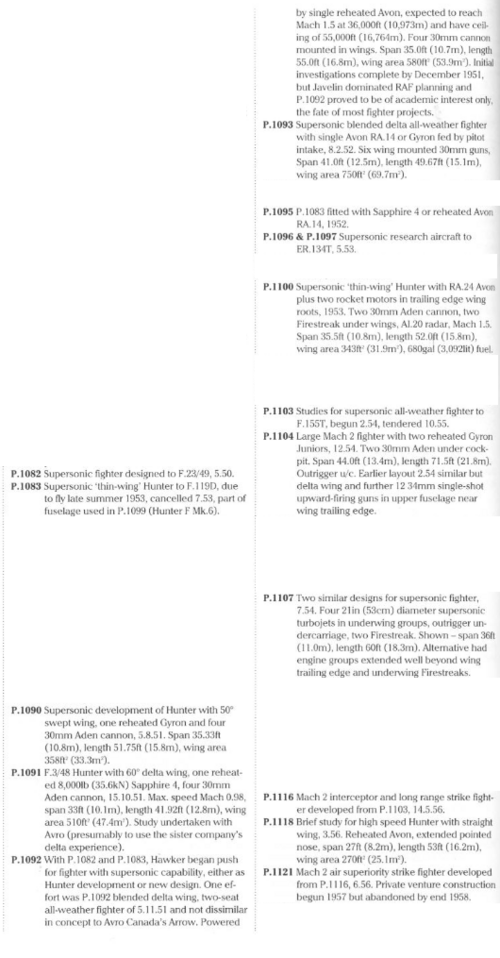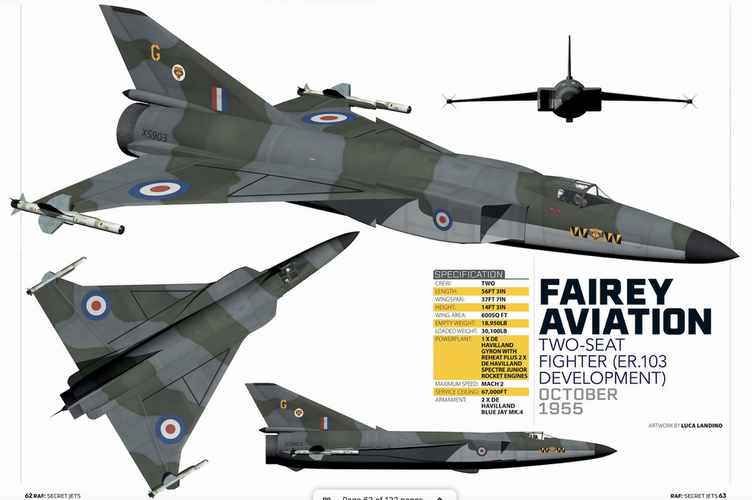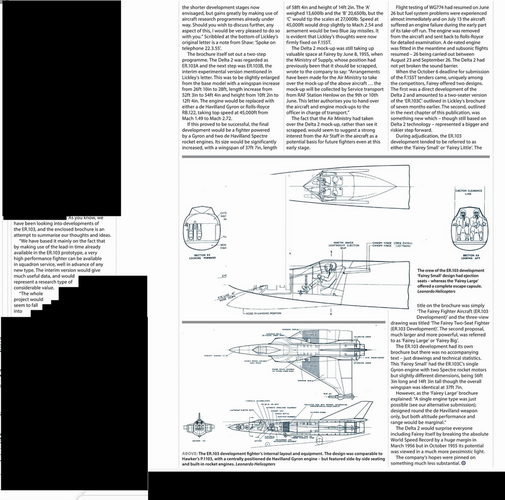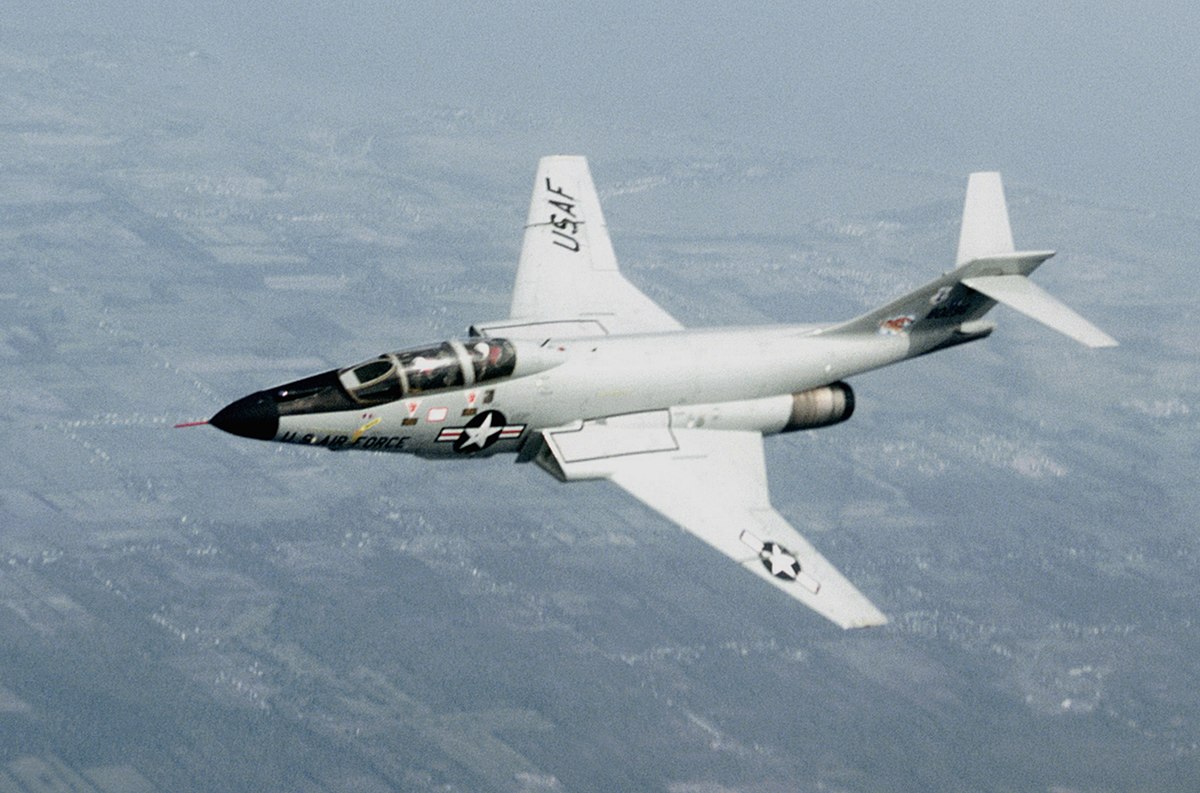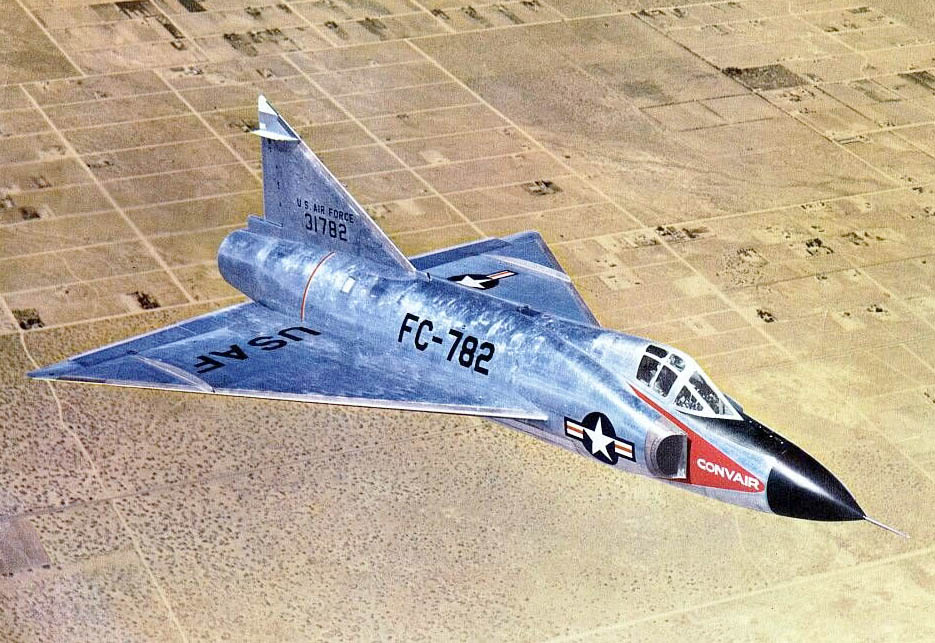a) spec _____late 1953?
Level flight to Mach 2+ above 10,000ft?
Acceleration from cruise below Mach 0.8 to Mach 1.2 in X minutes?
Climb to 60,000ft in 4 minutes?
Radius of Action: Normal Waring Sortie 125nm?
Extended Waring Sortie....?
CAP endurance Minimum 2 hours at 100nm distance from base inclusive of 5 minutes combat.
Speed seems fair, as long as its over Mach 2 it should be fine. Climb seems fair (Fighter Command wanted 3 minutes for F.155 but that was not feasible and settled for 6 as a compromise. So 4 seems fair given we've a lighter aircraft.
For extended warning sortie, are we assuming internal fuel only or are we allowing external tanks?
Late 1953 seems ok, gives time to mull over Korean War experiences.
Minimum of 2 by 30mm ADEN cannons
Minimum of 2 by Firestreak IR AAMs
Minimum of 2 by radar guided AAMs
Equipment to include AI.23 or AI.20 Fighter Radar.
IFF
Radios
Radio homer
Use of single engined designs prefered. But flexible on specific engine.
Liking the missile armament.
AI.23 or AI.20 makes sense at this time, but hopefully AI.23 is the chosen set, this could be pre-specified I guess.
On engines, flexibility might be a good idea - I'm assuming Olympus, Gyron, RB.106 are most likely choices with Avon third as we're still fairly early into Avon development. Are we ruling out rockets, even for RATO? (I don't like em' but some designers might try to shoehorn them in).
Avro Type 720 derived Delta winged design
AWA Delta (AW.58), swept wing (AW.165) and straight wing designs
Blackburn crescent/cranked leading edge swept wing.
Bolton Paul
Bristol Delta or 188 type wing.
DeHaviland DH.116 derived design
English Electrics P.1 type swept wing
Fairey ER103 type tailless Delta wing and tailed swept wing
Folland Gnat MkV derivative
Gloster Javelin derived design.
Hadleigh Page crescent wing or canard Delta.
Hawkers P.1103 Type modest swept wing or blended tailless Delta wing.
Saro P.53 to P.177 type modest Delta with tail.
Shorts ?
Supermarine radical canard option, crescent and plain swept wing options.
Westland variant of W.37 or N/A.39 designs
I'd probably want to limit the tenders, especially since F.155 is in the pipeline for the year after. Both are big jobs. Historically F.155 invitations were AWA, DH, EE, Gloster, Hawker, Saro, Vickers-Supermarine and Westland. Then Westland was swapped for Fairey as Westland was felt to have done badly in NA.39. The 'B List' who got copies for information were Blackburn, Bristol, HP, Avro and Short.
So for this I'd suggest an 'A List' of: Avro, AWA, Bristol, DH, EE, Fairey, Gloster, Hawker, Vickers-Supermarine. 'B List': Blackburn, Boulton Paul, Westland. I don't think Folland is big or strong enough for this job, Short has no fighter experience and I'd see them as a sub-contractor perhaps for production. I don't really have faith in the 'B List' but they might offer something decent.
Admiralty express interest in writing parallel specification.
Good idea. Might impose some weight restrictions but might be worthwhile, also might open up possibilities of blown flaps etc.
Late 1954 ordering three prototypes, one from each of the three best designs.
I would disagree here. With my rationalisation hat on, this seems wasteful. To my eyes, if someone submits 'Dan Dare' designs then they are no good, a fighter should be fundamentally basic and any unique odds and sods can be booted out. Ideally we want only one single-seater and one two-seater (and looking ahead one tactical bomber - so 3 firms occupied). I'd only waiver on that if the Admiralty found a different design was suitable for carrier use and the others couldn't be easily adapted.
Flying by 1958 With assessment that year.
Choice by early 1959
IOC 1962
FOC by '65
I'm pushy, I'm the annoying Air Marshall thumping the table demanding it in service by 1960. That's 6 years from ITP.
Tendering companies likely designs:-
Avro Type 720 derived Delta winged design
AWA Delta (AW.58), swept wing (AW.165) and straight wing designs
Blackburn crescent/cranked leading edge swept wing.
Bolton Paul
Bristol Delta or 188 type wing.
DeHaviland DH.116 derived design
English Electrics P.1 type swept wing
Fairey ER103 type tailless Delta wing and tailed swept wing
Folland Gnat MkV derivative
Gloster Javelin derived design.
Hadleigh Page crescent wing or canard Delta.
Hawkers P.1103 Type modest swept wing or blended tailless Delta wing.
Saro P.53 to P.177 type modest Delta with tail.
Shorts ?
Supermarine radical canard option, crescent and plain swept wing options.
Westland variant of W.37 or N/A.39 designs
Avro - yes this seems likely. 725 had a ventral intake, 726 lateral intakes.
AWA - would be in good standing with work taking AW.58 to the next step. Presuming a nose intake with bullet.
Blackburn - not sure if they would attempt this or not, the B.97 rocket fighter to F.124 was pretty basic.
Boulton Paul - maybe a single-engined version of the P.121 with the fixed swept wing, the P.122 for F.124 was basically a Venom, not sure they really have the skills for this, though they have P.111 delta experience.
Bristol - I reckon they would enter something developed from the 178 submitted to F.124 - in effect a British F-104!
DH - are falling behind, like the DH.117 I feel it would be a conservative design, DH.116 would need a lot of work.
EE - probably the P.6.
Fairey - probably would offer cranked deltas and swept wing versions.
Gloster - they toyed with single Gyron-powered fighters in 1951 and in 1953 sketched P.362 developed from Javelin for ER.134. Whatever they offer is likely to be a Javelin development.
Hawker - so many choices! P.1096, P.1097, or the unsubmitted PO/108 shown in BSP:1 seem most likely. Even a jet-powered P.1089 (a mini Mirage!).
Saro - not invited in my list but assuming they offer anyway, P.154 to F.124 was fairly sleek, imagining it with wing root intakes or perhaps a single-engine P.163.
Short - PD.701 with a single engine perhaps.
V-Supermarine - super 545? There is the 553 too with nose intake, RB.106 and swept wings.
Westland - not hopeful given their odd entries to F.124
My shortlist likely to be: Avro, EE, Bristol, Fairey, Hawker, Supermarine.
So 3 deltas, 3 swept, at least 3 of them with RB.106. Not sure who yet I would chose as a winner.

